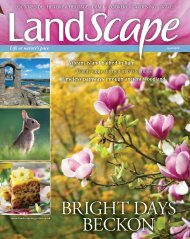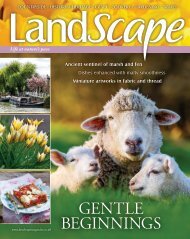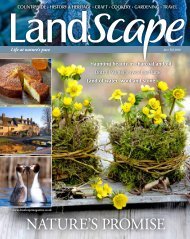You also want an ePaper? Increase the reach of your titles
YUMPU automatically turns print PDFs into web optimized ePapers that Google loves.
COUNTRYSIDE ▯ HISTORY & HERITAGE ▯ CRAFT ▯ COOKERY ▯ GARDENING ▯ TRAVEL<br />
Life at nature’s pace<br />
Ancient sentinel of marsh and fen<br />
Dishes enhanced with malty smoothness<br />
Miniature artworks in fabric and thread<br />
1<br />
www.landscapemagazine.co.uk<br />
GENTLE<br />
BEGINNINGS
Contents<br />
March 2018<br />
64<br />
92<br />
18<br />
In the garden<br />
In the kitchen<br />
Craft<br />
10 Species tulips reveal their treasure<br />
18 Tranquil plot comes to life<br />
26 The garden in March<br />
44 Woodland plants offer<br />
46 Growing miniature greens<br />
52 Fresh and tangy rhubarb<br />
60 Treat for teatime<br />
64 Dishes enhanced with silky stout<br />
70 Regional & Seasonal:<br />
The Cornish Seaweed Company<br />
30 Displays of heady hyacinths<br />
88 Cheery cushion knit<br />
100 Weaving twigs with colour<br />
4
112<br />
100 72 104<br />
Country matters<br />
History and heritage<br />
Regulars<br />
72 Fences brought to life<br />
104 A distinctive native breed<br />
38 Hillside home for ferns<br />
79 Cultivating a British brew<br />
92 Buttons of exquisite intricacy<br />
112 A tiny city’s Fenland triumph<br />
6 Readers’ letters<br />
8 Our <strong>LandScape</strong><br />
36 In the garden<br />
50 In the kitchen<br />
62 Subscription offer<br />
86 In the home<br />
122 UK events<br />
5
NATURAL<br />
ALLURE<br />
With their heady scent and rainbow<br />
hues, species tulips reveal a bewitching<br />
beauty as spring unfolds<br />
Growing to just 6in (15cm) in<br />
height, striking Tulipa tarda<br />
is best placed at the front of<br />
the border or rockery.<br />
Tulipa saxatilis ‘Lilac<br />
Wonder’ glows golden<br />
yellow at the base of its<br />
soft mauve-pink petals.<br />
AS THE EARLY spring garden slowly<br />
awakens, delicate blooms emerge to display<br />
their hidden treasures. Among the unfurling<br />
foliage, species tulips open to greet the gentle<br />
sun, revealing inner markings at the base of lustrous<br />
petals in a cocktail of colours. Shades of wine-red,<br />
purple or violet, gold, cream and white shine out in<br />
beds, borders, rockeries and pots. Some are<br />
intoxicatingly fragrant, others brilliantly colourful.<br />
Originating from the wild, species tulips retain a<br />
simple, refined beauty, the way nature intended.<br />
Dozens of different species grow across the steppes and<br />
mountainous regions of Central Asia. They were first<br />
introduced to Europe from Turkey in the 16th century.<br />
Here, they were destined to become the ancestors of the<br />
spectacular garden hybrids that dominate spring<br />
displays. These dazzle for a season but seldom return,<br />
unlike the originals, almost all of which reappear<br />
unbidden year after year.<br />
Species tulips are also known as botanical tulips, a<br />
name that misleadingly implies they are specialised and<br />
tricky to cultivate. “Tulip species are not difficult to<br />
grow, providing the conditions are right and, as they<br />
become more widely available, gardeners are being won<br />
over by their subtle beauty and longevity,” says Richard<br />
Wilford, author of Tulips, Species and Hybrids for the<br />
Gardener. He is also the manager of garden design and<br />
collection support at the Royal Botanic Gardens, Kew. ›<br />
10
A burst of Tulipa turkestanica.<br />
A bulb bears up to a dozen<br />
white star-shaped flowers 1-2in<br />
(3-5cm) wide, showing deep<br />
yellow at the base.<br />
11
After lying derelict for almost a<br />
century, the Benmore Fernery has<br />
been painstakingly rebuilt.<br />
RESTORED TO GRANDEUR<br />
Perched high against a rugged ravine, a renovated glasshouse is<br />
home once more to a collection of delicate ferns<br />
38
IN A REMOTE spot in the wild Argyll landscape sits a<br />
as a fashionable addition to estates and gardens at this period.<br />
unique building. Tucked away in a steep, south-west-facing<br />
Sadly, Duncan lost his fortune and the fernery went into<br />
gully on the Cowal peninsula, all that can be seen of it from decline, lying derelict for nearly 100 years. It was already in a<br />
below is the south wall that dominates the narrow ravine.<br />
neglected state when the Benmore Estate became an annexe of<br />
From above, it appears like a casket, clinging to the cliff side. the Royal Botanic Garden Edinburgh (RBGE) in 1928. By the<br />
This is the Benmore Fernery, built in 1874 at the height of a year 2000, it was a ruin. The thick rubble walls remained largely<br />
Victorian fern craze. In its heyday, it would have been filled with intact, but an interior arch over the entrance had become<br />
plants from as far away as Australia and the Americas. These dangerous and had been taken down. All that was left of the roof<br />
plants of warm temperate regions would not survive a British were a few distorted iron hoops still in place on the buttresses.<br />
winter without protection. Then, paths wound through the<br />
The internal landscape was exposed to the elements, including an<br />
greenery, stairs led to higher levels and water trickled through a annual rainfall of 80-120in (200-300cm). Broken wooden frames<br />
grotto. Built at the behest of Scottish businessman James<br />
from the glazed panels lay rotting on the fernery floor.<br />
Duncan, owner of the Benmore Estate, the fernery was regarded The fern collection had long since disappeared. Paths and ›<br />
39
“Here hyacinths of heavenly blue,<br />
shook their rich tresses to the morn.”<br />
James Montgomery, ‘The Adventure of a Star’<br />
Individual florets are scattered over<br />
a favourite silver spoon placed on a<br />
softly folded napkin, adding a bright<br />
welcome to the breakfast table.<br />
Twin blooms are slipped into a clean glass bottle,<br />
in a vintage metal crate. Wooden spoons are stored<br />
alongside, mirroring the arrangement, to create a<br />
pretty and practical display.<br />
32<br />
Sprigs of thyme stand beside a single<br />
hyacinth, their dusty green leaves<br />
offsetting its rich lilac petals. This<br />
fragrant pairing brings a touch of<br />
scent to a tabletop decoration.<br />
Photography: Living4Media; Florapress; PlainPicture
Bundles of pink<br />
hyacinths fill a<br />
china teapot, with<br />
slender budding<br />
twigs hinting at the<br />
coming spring.<br />
33
The silhouette of a pear tree,<br />
Pyrus nivalis, underplanted with<br />
clipped box square, creates a<br />
focal point behind the house.<br />
Narcissus pseudonarcissus<br />
trumpets spring’s arrival.<br />
Fragrant Narcissus actaea, with its<br />
cupped, red-edged centre.<br />
trumpets and white twisted petals are equally delicate. So far,<br />
both these have gained full marks for endurance and charm.<br />
The plantings are united by the nodding bells of<br />
snakeshead fritillaries, Fritillaria meleagris, that have spread<br />
throughout the area. They particularly relish the heavy, damp<br />
soil. At the top of the mature oaks are raucous bands of<br />
rooks, rowdy with nests. “They eat my purple and blue<br />
crocus,” bemoans Keith.<br />
There is a special corner in the first orchard by the stream<br />
that surrounds the garden. Here stands an elegant white<br />
pergola that forms a shelter for the grave of their much-loved<br />
dog Gwenny, who died, aged 17, in 2011. ›<br />
“Now when the primrose makes a splendid show,<br />
And lilies face the March-winds in full blow,<br />
And humbler growths as moved with one desire<br />
Put on, to welcome spring, their best attire,”<br />
William Wordsworth, ‘Poor Robin’<br />
23
REGIONAL<br />
&<br />
SEASONAL<br />
TASTE OF THE OCEAN<br />
THE BEAUTIFUL WATERSIDE village of Gweek,<br />
with its clusters of whitewashed cottages, lies at the head<br />
of the Helford River in South Cornwall, on the edge of<br />
a verdant landscape. Once a bustling port, its history<br />
dates back to 450BC when it traded tin with the Phoenicians,<br />
and its name means forest village. Now best known for hosting<br />
the National Seal Centre, it is also home to a seaweed business.<br />
Owned by Caro Warwick-Evans and Tim van Berkel, The<br />
Cornish Seaweed Company was created five years ago, more by<br />
accident than planning. The pair met at university, and on<br />
finishing, Caro moved abroad to work in renewable energy with<br />
remote communities while Tim involved himself with wildlife<br />
and conservation. “A serious motorbike accident brought Caro<br />
back to the UK, and she settled in Cornwall,” explains Tim.<br />
“For me, the lure of the sea has always been strong, so a move<br />
back to the coast was a natural progression.”<br />
Jobs can be hard to find in Cornwall, so the pair struggled.<br />
“The turning point came in 2011 when Caro listened to an<br />
episode of Farming Today,” says Tim. “The programme featured<br />
seaweed; the benefits of it and how it was farmed in Ireland. It<br />
seemed there was an untapped market in the UK. We both love<br />
surfing and snorkelling, and appreciate good food.”<br />
Seaweed is high in vitamins and minerals, including iron and<br />
calcium. It is sustainable and becoming more popular. Though it<br />
grows plentifully on the Cornish coast, the pair did not initially<br />
have the skills to harvest and produce it. They turned to Irish<br />
company, AlgAran in County Donegal, who were keen to help.<br />
Caro worked for them for two weeks to learn the trade.<br />
“We started small scale, and the first three years were tough,”<br />
explains Tim. “We lived in caravans and worked every day. It<br />
finally paid off, as we are now bigger and more profitable than<br />
we ever imagined.” The business operates from a large warehouse<br />
shared with a local salt producer.<br />
The seaweed is sold directly to restaurants and food<br />
producers as an ingredient for sausages and salami. They also<br />
have a selection of seaweeds and skincare products for sale to the<br />
general public, online.<br />
At spring low tides, the seaweed can be picked from the<br />
beach. This traditional method is much better for the seabed and<br />
ecosystems than larger-scale machine harvesting. Most of the<br />
seaweed is found around Coverack and on the east coast of The<br />
Lizard. The north coast of Cornwall is also productive.<br />
At other times, it is reached by diving. “Seaweed grows in<br />
abundance, but we are only allowed to harvest in particular<br />
70
A passion for coastal life has led to a<br />
thriving Cornish seaweed business<br />
All-Green Soup<br />
75g fresh or 10g dried<br />
sea spaghetti<br />
1 tbsp olive oil<br />
2 leeks, chopped<br />
2 courgettes, diced<br />
200g frozen peas<br />
200g spinach<br />
200g cabbage, diced<br />
1.3 litres vegetable stock<br />
2 handfuls fresh basil<br />
salt and ground black<br />
pepper<br />
Photography: Emli Bendixen; Tom Holmes<br />
places and definitely not in a conservation area, or polluted<br />
water,” says Tim. “It was tricky to find out who owns the land.<br />
It’s a mixture of the Duchy, private landowners and the council.<br />
We had to apply for a licence to pick before we could trade.”<br />
The seaweed season varies from species to species. At peak<br />
times, the company employs six part-time pickers and three<br />
packers/harvest managers. Depending on the tides, the pickers<br />
may only need to wade into the water. If free diving is necessary,<br />
it is to a maximum depth of 16ft (5m), and trusty boat the<br />
Cornish Sea Badger is called into action.<br />
“I love to dive, as the water is usually clear and I can watch<br />
the fish, jellyfish and spider crabs nipping about. It’s only if<br />
there’s been a storm that the water becomes clouded. Some<br />
species of seaweed are hard to find, so it’s more of a challenge<br />
than you think. We are in the hands of the moon, tide and swell,<br />
and in the end, the sea decides if we will get a harvest or not.”<br />
Once picked, the seaweed is put into bags so it can be<br />
weighed to calculate water content. It is given a thorough wash<br />
and then laid on racks in polytunnels to dry in the heat of the<br />
sun. This can take from just a few hours to four days. Once dry,<br />
it is re-weighed and packaged up, ready to sell. Some is made<br />
into flakes, using a hammer mill, to add to biscuits.<br />
If using dried sea spaghetti, rehydrate in cold water for 10 mins,<br />
prior to cooking. The water can be used to make up some of the<br />
stock. In a large pan, heat the olive oil and add the leeks. Fry<br />
gently for a few minutes until they begin to soften, then add the<br />
courgettes. Continue to fry until both are softened. Add the peas,<br />
spinach, seaweed and cabbage and cover with the stock. Bring to<br />
the boil, then simmer for 20 mins until the contents of the pan are<br />
very soft. Add the basil and blend. Season to taste and serve.<br />
▯ Recipe: The Seaweed Cookbook: A guide to edible seaweeds and how to cook with them,<br />
by Caroline Warwick-Evans and Tim van Berkel, £15 www.annesspubishing.com<br />
Tim is in his element as a seaweeder and cannot now<br />
imagine doing anything else. “I enjoy eating seaweed. Fresh<br />
spaghetti is my favourite, and it can be eaten cooked or raw.<br />
We work hard at educating others on the benefits of this<br />
quality foodstuff. Interest is growing, and I am hopeful that it<br />
will become a staple part of the British diet in the future.”<br />
▯ Words: Julie Brown<br />
CONTACT<br />
www.cornishseaweed.co.uk<br />
71
Rhubarb, ginger and vanilla scone ring<br />
Makes 10<br />
400g rhubarb,<br />
trimmed and cut into<br />
6cm pieces<br />
60g stem ginger,<br />
thinly sliced<br />
2 tbsp vanilla bean<br />
paste<br />
260g self-raising flour,<br />
plus extra for dusting<br />
50g chilled unsalted<br />
butter, cubed<br />
2 tbsp caster sugar<br />
100ml milk, plus extra<br />
for brushing<br />
Preheat the oven to 200°C/gas mark 6. Place<br />
the rhubarb pieces on an oven tray lined with<br />
baking paper. Bake for 15 mins, then allow to<br />
cool. Drain any excess water from the cooked<br />
rhubarb. Turn the oven up to 220°C/gas mark 7.<br />
Sieve the flour into a large bowl, then add the<br />
butter and rub it into the flour by pinching it<br />
together swiftly using fingers and thumbs. Stir in<br />
the sugar with a wooden spoon. Measure out<br />
the milk in a jug, then stir in the vanilla paste<br />
until combined. Add the milk and vanilla to the<br />
dry mixture and bring together into a dough. Add<br />
the ginger and baked rhubarb, and mix together.<br />
Use the hands to bring all the ingredients<br />
together into a dough and knead for 2 mins.<br />
On a clean surface dusted with flour, roll out<br />
the dough to approximately 2cm thick. Using a<br />
6cm fluted cookie cutter, cut out as many<br />
scones as possible. Place them side by side<br />
around the inner edge of a 25cm round tart tin<br />
dusted liberally with flour, to start forming a<br />
circle. Roll out the remaining dough again and<br />
repeat the process until there is little or no<br />
dough left and the scone circle is complete.<br />
Brush with milk and bake for 15-20 mins until<br />
golden and fluffy. Allow the scone ring to cool<br />
slightly on the tray, then transfer to a cooling<br />
tray to cool completely.
WOOLLY COMPANION<br />
88
MATERIALS<br />
• 10mm circular needle, no<br />
more than 80cm long<br />
• 4.5mm pair of straight<br />
knitting needles<br />
• 6mm crochet hook<br />
• Rowan Big Wool, 3 x 100g balls,<br />
shade 001<br />
• Rowan Hemp Tweed, 1 x 50g ball,<br />
shade 138, Pumice<br />
• Small amount of black DK yarn<br />
for features<br />
• Spare contrast yarn for stitch marker<br />
• Cushion pad 18 x 14in (46 x 36cm)<br />
• 6 buttons approximately 25mm<br />
diameter<br />
• Sewing thread for the buttons<br />
• Large handful of toy filling for the<br />
head and feet<br />
• Blunt tapestry needle<br />
Finished Size<br />
Approximately 18 x 14in (46 x 36cm)<br />
Tension<br />
Body of cushion: 9 stitches x 10 rows<br />
over 4in (10cm) in loop stitch<br />
Head: 19 stitches x 28 rows over 4in<br />
(10cm) in stocking stitch<br />
This eye-catching sheep cushion is a delight to knit<br />
with his cosy loop stitch body and expressive face<br />
Abbreviations<br />
K Knit<br />
P Purl<br />
K2tog Knit two stitches together<br />
P2tog Purl two stitches together<br />
RS Right side<br />
St(s) Stitch(es)<br />
Kfb Knit into the front and back of stitch<br />
M1 Make a stitch. With the left needle,<br />
lift the strand from front to back between<br />
two stitches, creating a new stitch. Knit<br />
the new stitch through the back of the loop<br />
M1p Make a stitch purl wise. With the<br />
left needle, lift the strand from front to<br />
back between two stitches, creating a<br />
new stitch. Purl the new stitch through<br />
the back of the loop<br />
ML Make a loop stitch. Knit the next stitch,<br />
but do not slip the stitch off the needle.<br />
Bring the working yarn forward and wrap<br />
the yarn around the left thumb to make a<br />
loop, approximately 1in (3cm) long. Pass the<br />
working yarn back between the two needles<br />
and knit into the front of the same stitch. This<br />
time, slip the stitch off the left needle, as for<br />
a normal knit stitch. Pass the previous knit<br />
stitch over the loop stitch to secure it.<br />
Give the loop a little tug to adjust the length<br />
as the row is worked. ›<br />
89
BEAUTY IN A BUTTON<br />
92
Anna McDowell uses intricate threadwork to create Dorset buttons,<br />
tiny works of art with a unique 400-year history<br />
93
Visitors can take a guided tour to the top of the Octagon, climbing 165 steps and ducking through low portals to walk on the lantern’s aged timber<br />
beams (above). In contrast to the main cathedral, the light-filled Lady Chapel has no stained glass (below left). The kneelers are worked to show<br />
the saint’s symbol and name, along with the parish (below right).
Black velvet cake<br />
Serves 12<br />
250ml stout<br />
250g unsalted butter, plus<br />
extra for greasing<br />
250g caster sugar<br />
50g cocoa powder<br />
2 eggs<br />
150ml double cream<br />
15g black food<br />
colouring gel<br />
280g plain flour<br />
1 tbsp bicarbonate of soda<br />
150g dark chocolate,<br />
broken into small pieces<br />
100ml sour cream<br />
500g icing sugar<br />
Preheat the oven to 180°C/gas mark 4. Grease and line a 23cm round cake tin. In a large<br />
mixing bowl, cream the butter with the sugar with the back of a wooden spoon for 2-3 mins<br />
until creamy. Mix in the cocoa powder, then beat in the eggs one at a time. Stir in the double<br />
cream, black food colouring gel and the stout, whisking until combined. Sift in the flour and<br />
bicarbonate of soda, and fold until combined. Add the small pieces of chocolate and mix in.<br />
Transfer the mixture to the tin and bake for 50-55 mins until an inserted skewer comes<br />
out clean. Allow the cake to cool in the tin, then remove the baking paper, saving the crumbs<br />
that fall away from the cake for decoration. Place the cake on a serving plate.<br />
In a large bowl, mix together the sour cream and icing sugar until smooth. Pour over the<br />
cake and sprinkle with the reserved cake crumbs.<br />
66
Discover more<br />
with Landscape<br />
Click here to<br />
order your copy<br />
directly to your door<br />
today, with free<br />
UK delivery<br />
GORGEOUS GARDENING, INSPIRATIONAL COOKERY,<br />
WONDERFUL HERITAGE, EXQUISITE CRAFT AND MUCH MORE<br />
Live life at nature’s pace
















